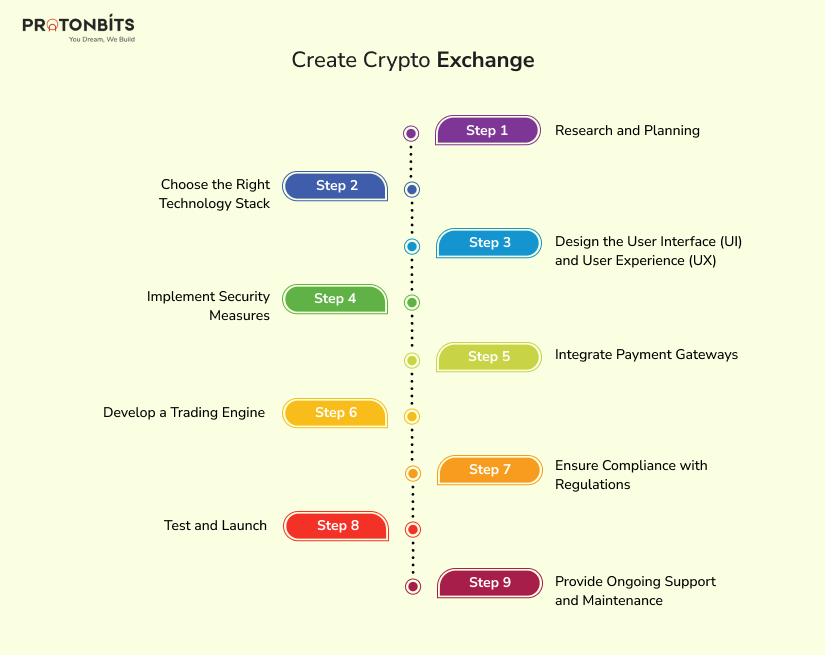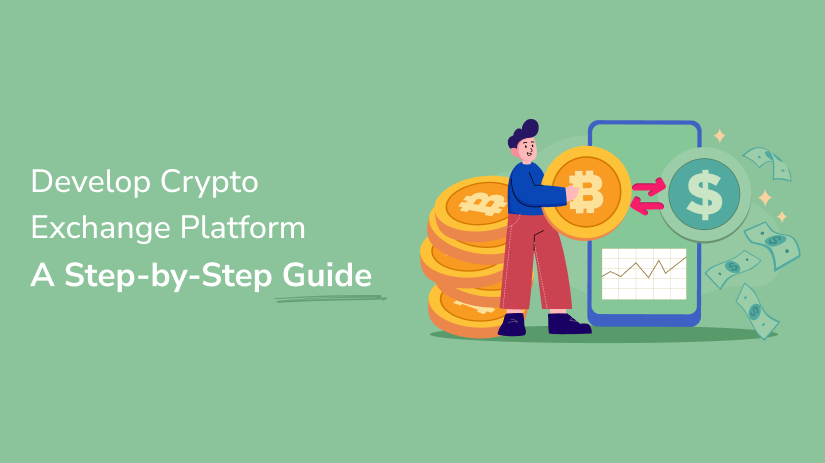In recent years, cryptocurrencies have surged in popularity, and with that, the demand for crypto exchange platforms has soared.
These platforms are the backbone of the digital currency market, facilitating the buying, selling, and trading of various cryptocurrencies.
If you’re looking to capitalize on this growing trend by creating your crypto exchange platform, you’ve come to the right place.
In this step-by-step guide, we’ll walk you through the process of developing a crypto exchange platform.
Let’s Start!!
Key Steps to Develop Cryptocurrency Exchange Platform

Step 1: Research and Planning
Before diving into fintech application development of crypto exchange, it’s crucial to conduct thorough research and planning. Familiarize yourself with the legal and regulatory requirements in your target market.
Understand the competitive landscape and identify gaps or opportunities for your exchange. Define your target audience and establish clear goals for your platform.
Step 2: Choose the Right Technology Stack
The right technology stack is essential for building a robust and scalable crypto exchange platform. Consider security, performance, and scalability factors when choosing your technology stack.
Some popular choices to build cryptocurrency exchange platforms include programming languages like Python, Java, or C++, along with frameworks like Ruby on Rails, Node.js, or Django. Additionally, you’ll need to choose the appropriate database, web servers, and security protocols.
Step 3: Design the User Interface (UI) and User Experience (UX)
The user interface and experience play a significant role in the success of your crypto exchange platform.
Design an intuitive and user-friendly interface that makes it easy for users to navigate the platform, execute trades, and access relevant information. Pay attention to factors such as responsiveness, accessibility, and visual aesthetics.
Connect with us for Fintech Development Needs
Trusted by companies like Plaid, Yodlee, Codat.
Step 4: Implement Security Measures
Security is paramount when it comes to handling digital assets and sensitive user information. Implement robust security measures to protect your exchange from hacks, data breaches, and other cyber threats.
This includes using encryption protocols, multi-factor authentication, cold storage for storing cryptocurrencies, and regular security audits.
Step 5: Integrate Payment Gateways
To enable users to deposit and withdraw funds, you’ll need to integrate payment gateways into your exchange platform.
Support for various payment methods such as bank transfers, credit/debit cards, and cryptocurrencies will enhance the accessibility and convenience of your platform.
There are many popular fintech APIs available to enable tasks such as linking bank accounts, adding UPI options, bank transfers, adding credit/debit cards, and so on. Coinbase API integration, Binance integration, BlockCypher integration, etc. are the preferable crypto exchange API integrations.
Step 6: Develop a Trading Engine
The trading engine is the heart of any crypto exchange platform. It’s responsible for matching buy and sell orders, executing trades, and maintaining order books.
Develop a robust and efficient trading engine that can handle high trading volumes and provide real-time market data to users.
Step 7: Ensure Compliance with Regulations
Compliance with regulatory requirements is essential for operating a legal and legitimate cryptocurrency exchange platform. Depending on your jurisdiction, you may need to obtain licenses or registrations from relevant regulatory authorities.
Stay informed about any changes or updates to regulatory frameworks and ensure that your platform remains compliant at all times.
Step 8: Test and Launch
Before launching your crypto exchange platform, thoroughly test all aspects of the platform to identify and fix any bugs or issues.
Conduct user acceptance testing (UAT) to gather feedback from real users and make necessary improvements.
Once you’re confident in the stability and functionality of your platform, you can proceed with the official launch.
Step 9: Provide Ongoing Support and Maintenance
Launching your crypto exchange platform is just the beginning. To ensure its long-term success, provide ongoing support and maintenance to address any technical issues, update security protocols, and implement new features based on user feedback and market trends.
Conclusion
In conclusion, developing a crypto exchange platform requires careful planning, technical expertise, and a commitment to security and compliance.
By following this step-by-step guide and staying abreast of industry developments, you can create a successful and sustainable crypto exchange platform that meets the needs of users in the fast-paced world of digital currencies.
Happy Crypto Exchange!!
Connect with us for Fintech Development Needs
Trusted by companies like Plaid, Yodlee, Codat.





